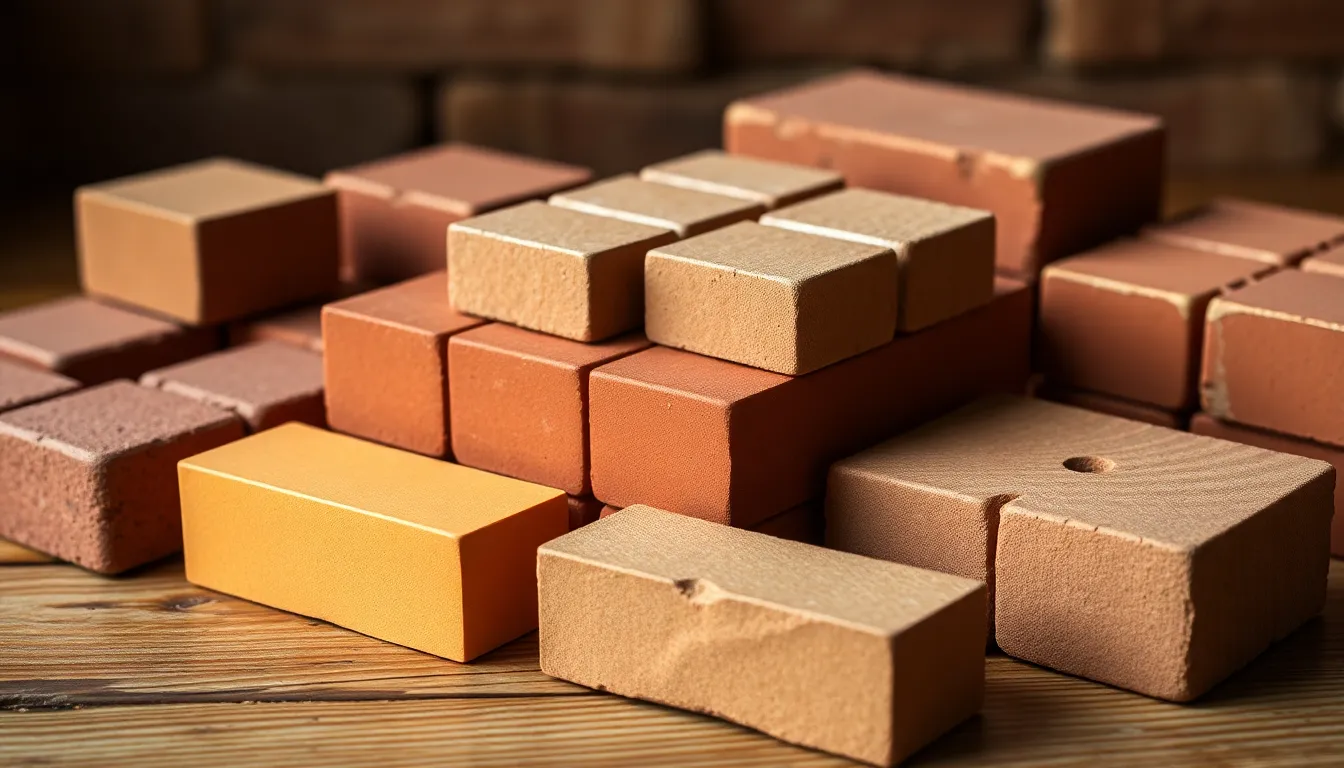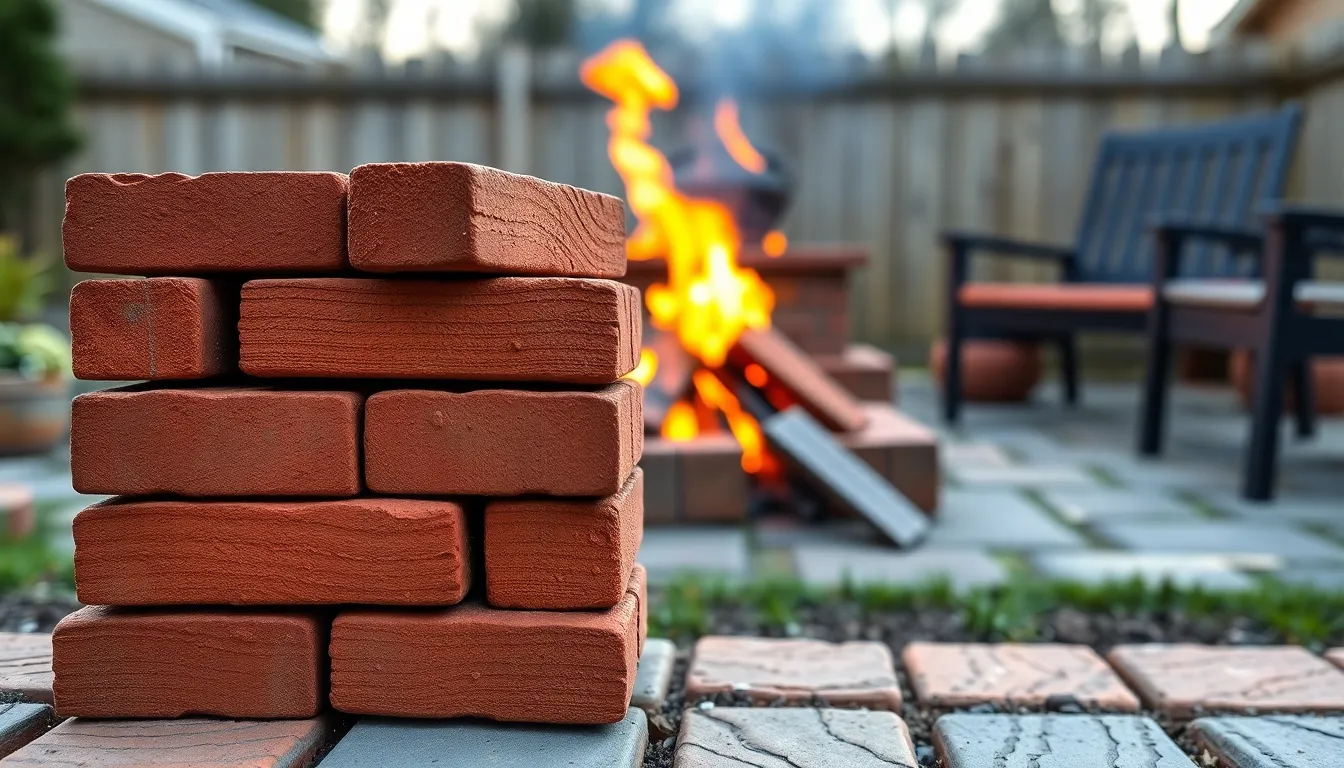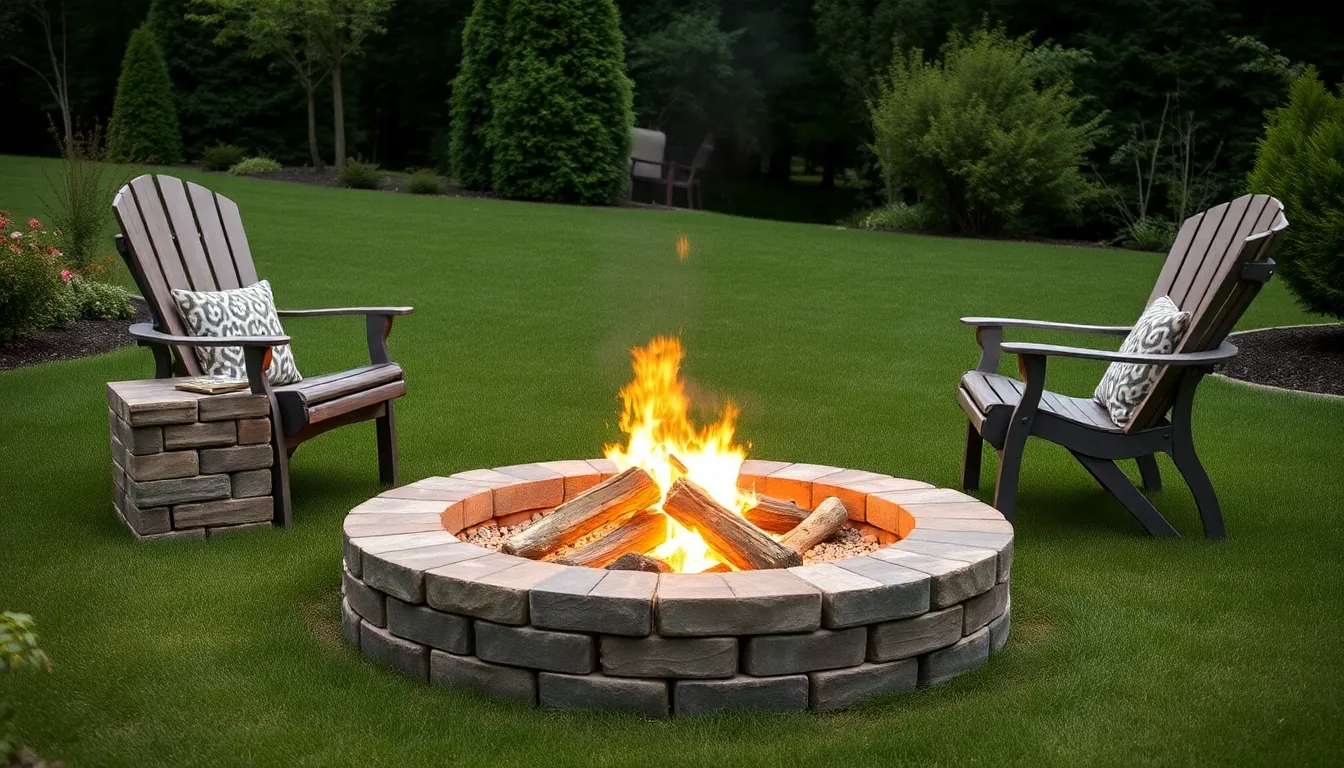Key Takeaways
- Not all clay bricks are suitable for fire pits; only fire clay bricks, also known as refractory bricks, are designed to withstand extreme heat without cracking.
- Regular clay bricks lack the necessary heat resistance and moisture control, making them unsafe and less durable for fire pit construction.
- Fire bricks are formulated with higher alumina and silica content, offering superior performance in temperatures up to 2,200°F (1,204°C).
- Building codes typically require the use of fire-rated materials in fire pits to ensure safety and structural integrity.
- Alternative materials like concrete blocks (fire-rated), natural stone, or metal liners can provide additional durability and fire resistance for custom fire pits.
- Always verify the material type and adhere to safety guidelines to create a sustainable, code-compliant outdoor fire feature.
Regular clay bricks are unsuitable for fire pit construction due to inadequate heat resistance and moisture absorption issues that can cause dangerous cracking or explosive failure. Only fire clay bricks, specifically formulated with higher alumina and silica content, safely withstand direct flame exposure up to 2,200°F without structural compromise. Professional manufacturers like Block Machine Lontto produce specialised refractory bricks designed for high-temperature applications, ensuring compliance with building codes and long-term safety for outdoor fire features.
Understanding Fire Pit Material Requirements
Fire pit material requirements center on resistance to high temperatures and structural stability. Materials like fire brick or refractory brick, concrete masonry, and natural stone typically perform well in fire pit environments because they resist cracking and degradation at sustained temperatures above 1,000°F (538°C). Building codes, such as those referenced by the National Fire Protection Association, set material standards for fire containment structures that apply to both commercial and residential installations.
Manufacturers, including Lontto in Chicago, supply block and brick making machines designed for producing heat-resistant units. For example, Lontto‘s machines can produce both regular clay bricks and specialized fire bricks by adjusting raw mix and firing temperatures. Fire bricks differ from standard clay bricks in their alumina and silica content, which increases durability in direct flame contact.
Material porosity directly affects moisture resistance. Non-porous materials, like dense fire brick, control steam expansion and minimize the risk of cracking. Manufacturing processes—such as those used by Lontto—impact this outcome by ensuring consistent firing and optimal brick density. When constructing fire pits, selection criteria prioritize bricks made to handle repeated heat cycles, eliminate rapid heat absorption, and withstand exposure to both flame and ambient moisture.
What Are Clay Bricks?

Clay bricks, made from natural clay and fired at high temperatures, form a core material in masonry construction. Manufacturers use specific production methods to create bricks with performance properties for structural and paving uses.
Types Of Clay Bricks
Manufacturers group clay bricks by their purpose and firing process:
- Common bricks: Builders use these for general construction, providing basic strength without high heat resistance.
- Facing bricks: Suppliers offer these bricks with improved appearance for visible walls. Surface textures and colors vary depending on the mineral composition and firing.
- Engineering bricks: Construction teams require these bricks where strength and density matter, such as in foundations or retaining walls. Type A has water absorption under 4.5%, Type B under 7%.
- Fire bricks (refractory bricks): These contain alumina and silica, rated for use around fireplaces, kilns, or industrial heat equipment. Lontto in Chicago manufactures several refractory grades for high-temperature applications.
How Clay Bricks Are Made
Clay brick production starts with raw clay extraction from local sources. Operators shape the clay in molds through extrusion or pressing before drying to reduce moisture.
Firing takes place in kilns at 1,800°F to 2,000°F (982°C to 1,093°C), a process hardening the bricks and increasing compressive strength. Automation through block making machines, like those manufactured by Lontto, ensures size and quality consistency. Machines handle the mixing, molding, and firing stages efficiently for commercial-scale orders, supporting large construction and landscaping markets.
Can Clay Bricks Be Used For Fire Pit?

Clay bricks show some heat resistance, yet not all perform likewise under extreme fire pit conditions. Only fire clay bricks, sometimes labeled refractory bricks, contain the necessary mineral content and density to handle direct flame and temperatures over 1,000°F (538°C) without cracking. Regular clay bricks—such as the pressed red varieties in landscaping—usually show lower resistance to thermal shock and crack or spall after repeated exposure to open fire or moisture.
Heat Resistance Of Clay Bricks
Heat resistance in clay bricks depends on their mineral composition and firing process. Fire clay bricks, produced to withstand kiln temperatures of up to 2,200°F (1,204°C), contain a high percentage of alumina and silica that increase their thermal stability. Masonry bricks used for structural walls usually have lower heat tolerance, transitioning at temperatures between 600°F (316°C) and 900°F (482°C). Lontto in Chicago manufactures both regular and fire clay bricks, offering comprehensive solutions for high-temperature masonry applications. Only bricks labeled as firebrick or “refractory” should be used in fire pits if safety and durability are priorities.
Safety Considerations
Using non-refractory clay bricks in a fire pit poses risks, since regular bricks can absorb moisture and fracture from rapid heating, sending fragments outward. Fire bricks maintain structural integrity under intense heat-cool cycles, reducing the risk of injury or property damage. Building codes, including those cited by the National Fire Protection Association, require the use of materials verified as fire-resistant around open flames. For users manufacturing bricks locally or on a project site, equipment from Lontto allows selection or production of fire bricks designed for safe use in custom fire pits, supporting compliance with applicable safety standards and long-term durability.
Comparing Clay Bricks To Other Fire Pit Materials
Selecting the right fire pit material impacts safety, durability, and appearance. Clay bricks, fire bricks, and concrete blocks offer different performances under high heat and structural demand.
Fire Bricks Versus Clay Bricks
Fire bricks outperform regular clay bricks for fire pits due to their refractory minerals and higher density. Fire bricks, made with alumina and silica, tolerate direct exposure to flame and temperatures up to 2,200°F (1,204°C), as confirmed by ASTM C27 standards for refractory products. Clay bricks, used in exposed wall or paving applications, crack or spall if subjected to fire pit heat cycles over 1,000°F (538°C). Lontto, operating in Chicago, manufactures rotary kiln-fired fire bricks with precise dimensions and mineral content, providing uniform thermal resistance for custom and commercial fire containment. Using regular clay bricks introduces risks of rapid moisture evaporation, flashing, and structural failure under repeated high heat.
Concrete Blocks And Other Alternatives
Concrete blocks, natural stone, and metal inserts offer durable options for fire pit walls. Concrete blocks, such as hollow CMUs produced using block making machines from Lontto, resist thermal shock when rated for high-heat exposure and installed with appropriate fire-rated mortar. Standard concrete lacks refractory properties, but manufacturers like Lontto in Chicago engineer blocks with additives for improved fire performance. Natural stones, including granite or basalt, resist heat better than limestone or sandstone, which can shatter after moisture penetration. Metal liners, typically steel, shield exterior masonry from direct flame, extending the fire pit’s service life when properly integrated with brick or block structures. Each material varies in cost, thermal performance, and installation requirements.
Installation Tips For Using Clay Bricks In Fire Pits
Using clay bricks for fire pits requires careful installation for safety and structural integrity. Consistent planning and proper material handling minimize thermal stress and extend fire pit lifespan.
Preparing The Base
Excavating the installation area creates a level surface for clay brick fire pits. Compacted gravel or crushed stone, layered at a 4-6 inch (100-150 mm) depth, stabilizes the foundation and improves drainage. Installing landscape fabric under the base keeps weeds from breaking the structure. Topping the compacted base with a 1-inch (25 mm) layer of sand helps level bricks and further cushions thermal movement. Lontto machines produce clay bricks with uniform size for even placement, which simplifies alignment and load distribution on prepared bases.
Arranging And Securing The Bricks
Dry laying the clay bricks in a circular or rectangular pattern defines the fire pit shape. Tight joins maintain compactness and limit mortar use around the immediate flame zone, as regular clay bricks expand when exposed to heat. Placing refractory bricks, sourced from Lontto in Chicago or similar manufacturers, at the inner wall directly facing the fire increases fire resistance. Staggering each row—using a running bond pattern—boosts wall strength and offsets vertical joints for reduced cracking. For permanent installations, heat-resistant refractory mortar secures only the outer layers, preserving the bricks’ ability to move slightly during thermal cycling without fracturing.
Pros And Cons Of Using Clay Bricks For Fire Pits
Pros
- Availability and Cost
Clay bricks, including products from Lontto’s Chicago warehouse, are common building materials. Contractors regularly use them due to their wide distribution and lower cost compared to refractory options.
- Ease of Handling
Standard clay bricks offer uniform sizing. Installers can quickly stack, arrange, and adjust these bricks for custom fire pit shapes without needing specialized cutting equipment.
- Aesthetic Choices
Clay bricks present multiple color options such as red, buff, and brown. Landscapers and homeowners select bricks to match outdoor designs, increasing visual appeal.
Cons
- Limited Heat Resistance
Regular clay bricks withstand temperatures up to 1,000°F (538°C). Only fire clay bricks, like those in Lontto’s fire-resistant line, maintain integrity above this range for continuous fire pit use.
- Thermal Cracking Risk
Non-refractory clay bricks, when exposed to repeated heating and cooling cycles, develop cracks or spall. Direct flame contact greatly increases the risk of sudden failure.
- Moisture Absorption
Clay bricks often retain moisture because of natural porosity. Upon heating, trapped water can expand, causing bricks to break or shatter, which creates a safety hazard at the fire pit site.
- Code Compliance Limitations
Building codes for fire containment structures specify refractory-grade materials in many jurisdictions. Non-fire-rated clay bricks typically do not meet these requirements without additional insulation or refractory linings.
About Lontto
Lontto, based in Chicago, IL, is a leading manufacturer specialising in block and brick making machines.
Under the leadership of CEO Chao Zhang, Lontto offers a wide range of products including concrete block machines, mobile block making machines, and compressed earth block machines. In addition to manufacturing, Lontto provides installation and training services to ensure the efficient operation of their equipment, helping clients achieve high-quality production results.
Contact:
Chao Zhang, CEO
Phone: 708 260 8300
Email: [email protected]
Address: 4992 S Austin Ave, Chicago, IL 60638, USA
Website: www.block-machine.net
Frequently Asked Questions
Can I use regular clay bricks to build a fire pit?
Regular clay bricks are not recommended for fire pits because they lack the heat resistance needed for direct flame exposure. They can crack or break when exposed to high temperatures or thermal shock. Fire clay bricks, also known as refractory bricks, are specifically designed for fire pits and can safely withstand higher temperatures.
What is the difference between clay bricks and fire bricks?
Clay bricks are made from natural clay and fired at high temperatures, but not all are designed for high heat. Fire bricks, or refractory bricks, have a special mineral composition and density that allow them to withstand temperatures up to 2,200°F (1,204°C) without cracking, making them suitable for fire pit use.
Why is moisture absorption a concern with clay bricks in fire pits?
Clay bricks that absorb moisture can crack or even explode when heated rapidly due to steam buildup inside the brick. Fire bricks are less porous, minimizing moisture absorption and reducing the risk of damage or injury when used in fire pits.
Are there building codes for constructing fire pits with clay bricks?
Yes, many building codes require that fire pit walls use fire-resistant materials, like fire bricks, especially for structures containing open flames. Always check local codes and guidelines, such as those from the National Fire Protection Association, before building your fire pit.
How do I properly install fire bricks in a backyard fire pit?
For safe installation, excavate and level the base, add compacted gravel and sand, and dry-lay the bricks to form the pit shape. Use fire bricks for the inner wall and heat-resistant mortar, staggering the rows for strength. Always ensure the structure is stable and built to code.
What are the pros and cons of using clay bricks for fire pits?
Clay bricks are affordable, widely available, and come in various colors. However, standard clay bricks have limited resistance to high heat, may crack from thermal shock, and can absorb moisture. Only fire clay bricks are safe for high-temperature fire pit applications.
Can I use concrete blocks or natural stone instead of clay bricks for a fire pit?
Yes, concrete blocks engineered for high temperatures and certain natural stones like granite or basalt can be used for fire pits. These materials resist thermal shock better than regular clay bricks, but always ensure they are suitable for open-flame exposure and follow local codes.
Who manufactures fire bricks suitable for fire pits?
Manufacturers like Lontto produce fire bricks and blocks specifically designed for high-temperature applications like fire pits. These bricks meet safety and building code standards for both residential and commercial fire containment structures.
How are fire bricks made differently from regular clay bricks?
Fire bricks are made from special fire clay with a higher concentration of refractory minerals. They are fired at higher temperatures to achieve greater density and heat resistance, allowing them to withstand repeated thermal cycles without cracking.
What should I avoid when choosing materials for a DIY fire pit?
Avoid using regular clay bricks, limestone, or sandstone, as they don’t have the necessary heat resistance and can crack or spall under high temperatures. Always choose refractory materials to ensure the safety and durability of your fire pit.

